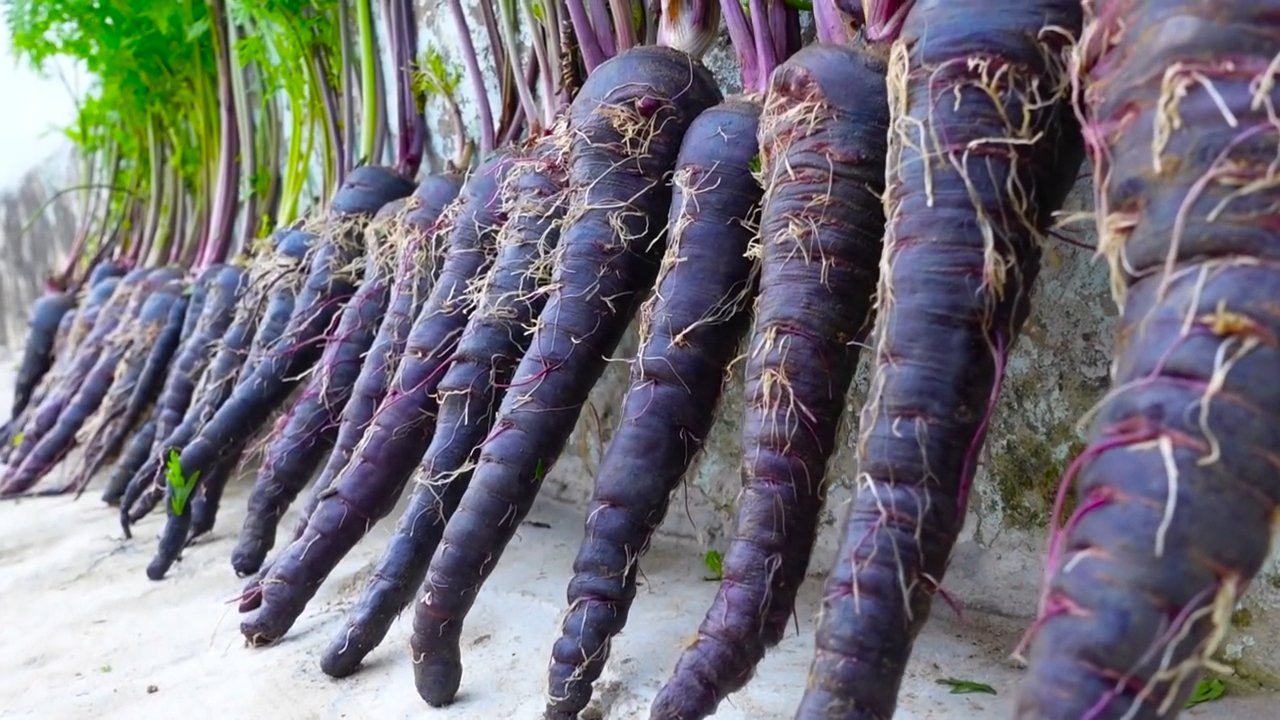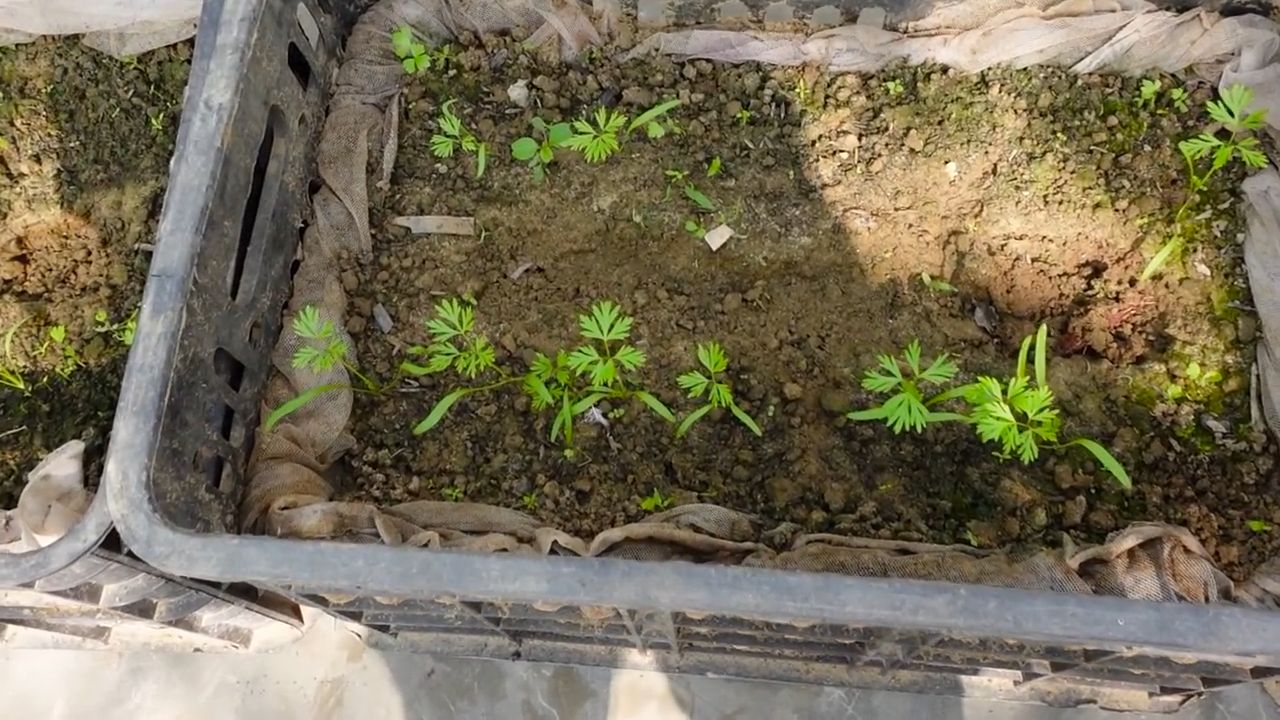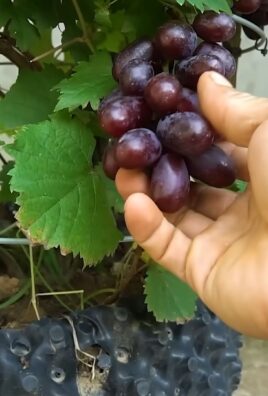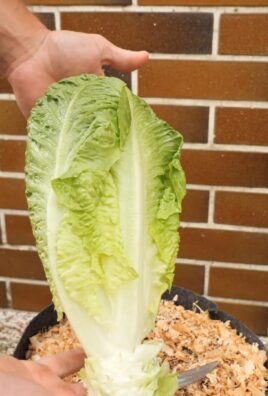Grow Purple Carrots at Home and unlock a vibrant splash of color in your garden and on your plate! Have you ever wondered how to add a touch of magic to your meals? Imagine pulling up carrots that aren’t just orange, but a stunning, royal purple. It’s easier than you think, and this DIY guide will show you exactly how to make it happen.
Purple carrots aren’t just a modern novelty; they boast a rich history, originating in the Middle East and Asia centuries ago. In fact, orange carrots are a relatively recent development! These colorful root vegetables were once the norm, prized for their unique flavor and impressive health benefits. They’re packed with anthocyanins, powerful antioxidants that give them their distinctive hue and contribute to overall well-being.
Why should you bother learning to grow purple carrots at home? Well, besides the sheer fun of it, growing your own food is incredibly rewarding. You control what goes into your produce, avoiding harmful pesticides and ensuring maximum freshness. Plus, adding purple carrots to your diet is a fantastic way to boost your nutrient intake and impress your friends and family with your culinary creations. I’m excited to share these simple DIY tricks and hacks that will help you cultivate a thriving purple carrot patch, even if you’re a beginner gardener. Let’s get started!

Growing Purple Carrots Yourself: A Colorful DIY Garden Project
Hey garden friends! Are you in the mood for something special in your vegetable patch? How about purple carrots? Yes, you read that right! These colorful roots are not only an eye-catcher, but also super healthy and not at all difficult to grow yourself. I’ll show you how you can easily do it at home. Let’s get started!
What You Need to Grow Purple Carrots
Before we begin, here is a list of everything you’ll need:
- Purple carrot seeds: You can find these online or in well-stocked garden centers. Make sure they are good quality!
- Suitable soil: Carrots love loose, sandy, loamy soil.
- Compost or organic fertilizer: For a good supply of nutrients.
- Watering can or garden hose: For regular watering.
- Gardening tools: Spade, rake, perhaps a small shovel.
- Plant markers: So you know where your purple carrots are growing.
- Patience: Carrots need some time to grow.
The Preparation: The Right Soil is Crucial
Carrots are a bit picky when it comes to soil. Good soil is the be-all and end-all for a rich harvest.
- Loosen the soil: Thoroughly dig up and loosen the soil with a spade. Carrots need space to grow deep.
- Remove stones: Remove all stones and large clumps. These can hinder the growth of the carrots and lead to crooked roots.
- Incorporate compost: Mix plenty of compost or organic fertilizer into the soil. This ensures a good supply of nutrients and improves the soil structure.
- Smooth the soil: Smooth and level the soil with a rake.
Sowing: How to Get the Seeds in the Ground
Now comes the exciting part: sowing!
- Make seed furrows: Use a rake or a stick to make seed furrows in the prepared soil. The furrows should be about 1-2 cm deep and 20-30 cm apart.
- Sow the seeds: Distribute the carrot seeds evenly in the furrows. Carrot seeds are very small, so it’s important not to sow too many seeds at once. You can also mix the seeds with some sand to help distribute them more evenly.
- Cover the seeds: Carefully cover the seeds with a thin layer of soil.
- Water: Gently water the seed furrows with a watering can or garden hose. Be careful not to wash the soil away.
- Label: Don’t forget to label the seed furrows with plant markers so you know where your purple carrots are growing.
The Care: Watering, Weeding, and Thinning
After sowing, it’s important to take good care of the carrots.
- Regular watering: Keep the soil evenly moist, but not wet. A sufficient water supply is especially important during germination and growth.
- Weeding: Regularly remove weeds that compete for nutrients. Weeds can severely impact the growth of the carrots.
- Thinning: When the carrot plants are about 5-10 cm high, you need to thin them. This means removing the weakest plants so that the remaining plants have enough space to grow. The distance between the plants should be about 3-5 cm.
Protection from Pests: How to Keep Your Carrots Healthy
Carrots can also be affected by pests. Here are a few tips on how you can protect your plants:
- Carrot fly: The carrot fly is a common pest that attacks the roots of the carrots. You can protect your plants with an insect net.
- Slugs and snails: Slugs and snails can eat the young carrot plants. You can use slug pellets or set up slug traps.
- Carrot leaf blight: This fungal disease can affect the leaves of the carrots. Ensure good air circulation and remove affected leaves.
The Harvest: Timing is Crucial
Finally, the time has come: the harvest!
- Harvest time: The harvest time depends on the variety and growing conditions. As a rule, carrots are ready for harvest after about 2-3 months. You can check the ripeness by carefully pulling one carrot out of the ground.
- Harvesting: Carefully pull the carrots out of the ground. If the soil is very firm, you can use a digging fork to loosen the soil.
- Cleaning: Remove the soil from the carrots and cut off the green tops.
Storage: How to Keep Your Purple Carrots Fresh
After the harvest, you’ll naturally want to keep your purple carrots fresh for as long as possible.
- Cool storage: Store the carrots in a cool, dark, and humid place. A cellar or refrigerator is well-suited.
- Sand box: You can also store the carrots in a box with moist sand. This keeps them fresh for a particularly long time.
- Don’t wash: Only wash the carrots just before eating, otherwise they will spoil more quickly.
Why Purple Carrots? The Benefits at a Glance
Purple carrots are not only a visual highlight but also have several health benefits:
- Anthocyanins: Purple carrots contain anthocyanins, which are powerful antioxidants that fight free radicals in the body and can thus protect against cell damage.
- Vitamin A: Like all carrots, purple carrots are rich in Vitamin A, which is important for vision, the immune system, and skin health.
- Fiber: Carrots are a good source of fiber, which promotes digestion and provides a long-lasting feeling of fullness.
- Variety: Purple carrots bring color and variety to the kitchen and are a great way to get children excited about vegetables.
Recipe Ideas: What You Can Conjure Up with Purple Carrots
Purple carrots are versatile and taste great raw, cooked, fried, or baked. Here are a few ideas:
- Raw: Simply peel and cut into sticks. Perfect as a snack or with dip.
- Salad: Grated purple carrots liven up any salad.
- Soup: Purple carrot soup is a real eye-catcher and tastes delicious.
- Roasted vegetables: Baked in the oven with other vegetables, purple carrots develop their full flavor.
- Puree: Purple carrot puree is a great side dish for meat or fish.
- Juice: Freshly squeezed purple carrot juice is a healthy and refreshing drink.
Conclusion: A Rewarding Garden Project
Growing purple carrots is a rewarding garden project that is not only fun but also promises a rich harvest of colorful and healthy vegetables. With the right tips and a little patience, you too can grow purple carrots at home and surprise your family and friends with this special delicacy. So, what are you waiting for? Get your seeds and get started! I wish you much success and a bountiful harvest!

Conclusion
So, there you have it! Growing your own vibrant, purple carrots at home is not only achievable but also a deeply rewarding experience. Forget the bland, mass-produced orange variety; imagine the burst of color and enhanced nutritional value you’ll bring to your table with these beauties. This isn’t just about adding another vegetable to your garden; it’s about embracing a unique culinary adventure and impressing your friends and family with your gardening prowess.
Why is this DIY trick a must-try? Because it empowers you to control the quality and freshness of your produce. You know exactly what goes into your carrots – no pesticides, no artificial fertilizers, just pure, natural goodness. Plus, the taste of homegrown vegetables is simply unparalleled. The sweetness and subtle earthy notes of freshly harvested purple carrots are a world away from anything you can buy in a store.
Beyond the basic method outlined, there’s plenty of room for experimentation. Consider trying different varieties of purple carrots, each with its own unique flavor profile and hue. Some are sweeter, some are spicier, and some boast a deeper, more intense purple color. You can also play around with companion planting. Marigolds, for example, are known to deter pests and attract beneficial insects, helping your carrots thrive. Another variation is to grow your purple carrots in containers. This is perfect for those with limited garden space or who want to keep their carrots closer to the kitchen for easy access. Just make sure the container is deep enough to accommodate the root growth.
Don’t be intimidated if you’re a beginner gardener. Growing purple carrots is surprisingly straightforward, and the satisfaction of harvesting your own colorful crop is well worth the effort. The vibrant color makes them a standout addition to any dish, from salads and roasted vegetable medleys to juices and even desserts. Imagine the stunning visual impact of a purple carrot cake!
We wholeheartedly encourage you to give this DIY trick a try. Start small, perhaps with just a few seeds, and gradually expand your purple carrot patch as you gain confidence. The process is not only educational but also incredibly therapeutic. There’s something deeply grounding about nurturing a plant from seed to harvest.
And most importantly, we want to hear about your experience! Share your photos, tips, and challenges in the comments section below. Let’s create a community of purple carrot enthusiasts and inspire others to embrace the joy of homegrown produce. Did you find a particular variety that thrived in your climate? Did you discover any clever pest control methods? Your insights could be invaluable to other gardeners. So, grab your seeds, get your hands dirty, and prepare to be amazed by the magic of growing your own purple carrots. This is more than just a recipe; it’s a journey into the world of vibrant, healthy, and delicious homegrown food. Let’s cultivate a colorful future, one purple carrot at a time!
Frequently Asked Questions (FAQ)
What exactly makes purple carrots purple?
The vibrant purple color of these carrots comes from a high concentration of anthocyanins, which are powerful antioxidants also found in blueberries, red cabbage, and other deeply colored fruits and vegetables. These pigments not only give the carrots their distinctive hue but also contribute to their health benefits. Anthocyanins are known for their anti-inflammatory and anti-cancer properties.
Are purple carrots different in taste or texture compared to orange carrots?
While the taste difference can be subtle, many people find that purple carrots have a slightly sweeter and sometimes slightly spicier flavor compared to traditional orange carrots. The texture is generally similar, although some varieties may be slightly denser. The key difference is the presence of anthocyanins, which can impart a slightly different mouthfeel.
When is the best time to plant purple carrots?
The best time to plant purple carrots depends on your climate. In general, they are a cool-season crop, so you should plant them in early spring or late summer/early fall. This allows them to mature in cooler temperatures, which promotes better color development and sweetness. Check your local planting guide for specific dates based on your region’s frost dates.
How much sunlight do purple carrots need?
Purple carrots need at least six hours of sunlight per day to thrive. Choose a location in your garden that receives full sun for optimal growth and color development. If you’re growing them in containers, make sure to place them in a sunny spot.
What kind of soil is best for growing purple carrots?
Purple carrots prefer loose, well-drained soil that is rich in organic matter. Amend your soil with compost or well-rotted manure before planting to improve drainage and fertility. Avoid heavy clay soils, as they can restrict root growth and lead to misshapen carrots. A slightly acidic soil pH (around 6.0 to 6.8) is ideal.
How often should I water my purple carrots?
Keep the soil consistently moist, but not waterlogged. Water deeply when the top inch of soil feels dry to the touch. Avoid overhead watering, as this can promote fungal diseases. Drip irrigation or soaker hoses are excellent options for providing consistent moisture to your carrot plants.
What are some common pests and diseases that affect purple carrots, and how can I prevent them?
Common pests that affect purple carrots include carrot rust flies, aphids, and nematodes. To prevent these pests, consider using row covers, practicing crop rotation, and introducing beneficial insects like ladybugs. Diseases that can affect purple carrots include leaf blight and root rot. To prevent these diseases, ensure good air circulation, avoid overwatering, and use disease-resistant varieties.
How do I know when my purple carrots are ready to harvest?
Purple carrots are typically ready to harvest when they reach the desired size, usually around 2-3 months after planting. Gently loosen the soil around the carrots and pull them up by the greens. You can also check the size of the carrot tops; if they are starting to push out of the soil, it’s a good indication that the carrots are ready to harvest.
Can I eat the carrot greens?
Yes, carrot greens are edible and nutritious! They have a slightly bitter taste, similar to parsley. You can use them in salads, soups, or pesto. Just make sure to wash them thoroughly before using them.
How do I store purple carrots after harvesting?
To store purple carrots, remove the greens, leaving about an inch of stem. Gently brush off any excess soil, but don’t wash them until you’re ready to use them. Store them in a cool, dark, and humid place, such as the refrigerator crisper drawer, in a plastic bag or container. They can last for several weeks when stored properly.
Can I grow purple carrots in containers?
Yes, you can absolutely grow purple carrots in containers! Choose a container that is at least 12 inches deep to accommodate the root growth. Use a well-draining potting mix and make sure the container has drainage holes. Water regularly and fertilize with a balanced fertilizer every few weeks.
Are there different varieties of purple carrots?
Yes, there are several varieties of purple carrots available, each with its own unique characteristics. Some popular varieties include ‘Purple Haze’, ‘Purple Dragon’, and ‘Cosmic Purple’. Experiment with different varieties to find the ones that you enjoy the most.
Will the purple color stain my hands or cooking utensils?
The anthocyanins in purple carrots can sometimes stain your hands or cooking utensils, but the staining is usually temporary and can be easily washed off with soap and water. To minimize staining, wear gloves when handling the carrots and wash your utensils immediately after use.
Can I save the seeds from my purple carrots to plant next year?
Saving seeds from carrots is a bit more involved than saving seeds from other vegetables, as carrots are biennials, meaning they take two years to produce seeds. You would need to overwinter the carrots and allow them to flower and produce seeds in the second year. This requires specific knowledge and techniques, so it’s often easier to purchase new seeds each year.
Are purple carrots more nutritious than orange carrots?
Purple carrots are indeed highly nutritious. While both orange and purple carrots are good sources of vitamins and minerals, purple carrots boast a higher concentration of anthocyanins, which are potent antioxidants. These antioxidants offer various health benefits, including reducing inflammation, protecting against cell damage, and potentially lowering the risk of chronic diseases. So, adding purple carrots to your diet is a great way to boost your overall health and well-being.




Leave a Comment